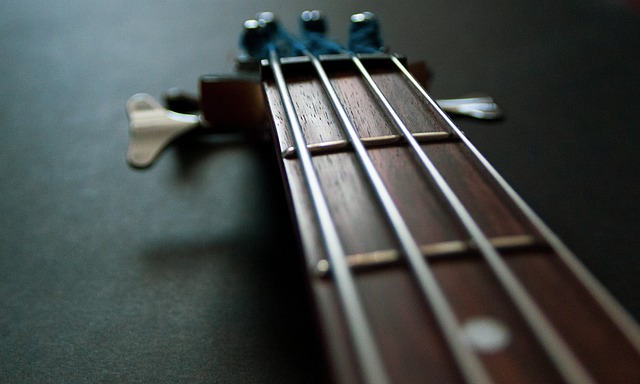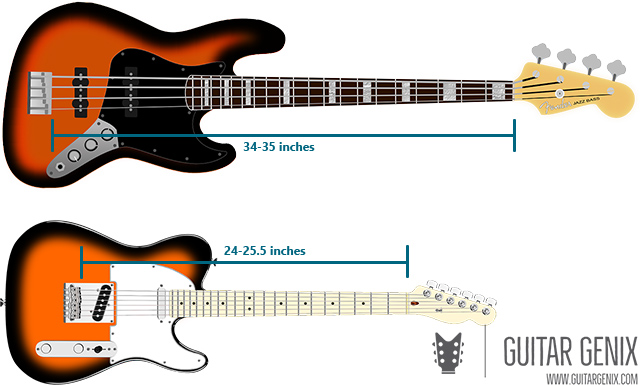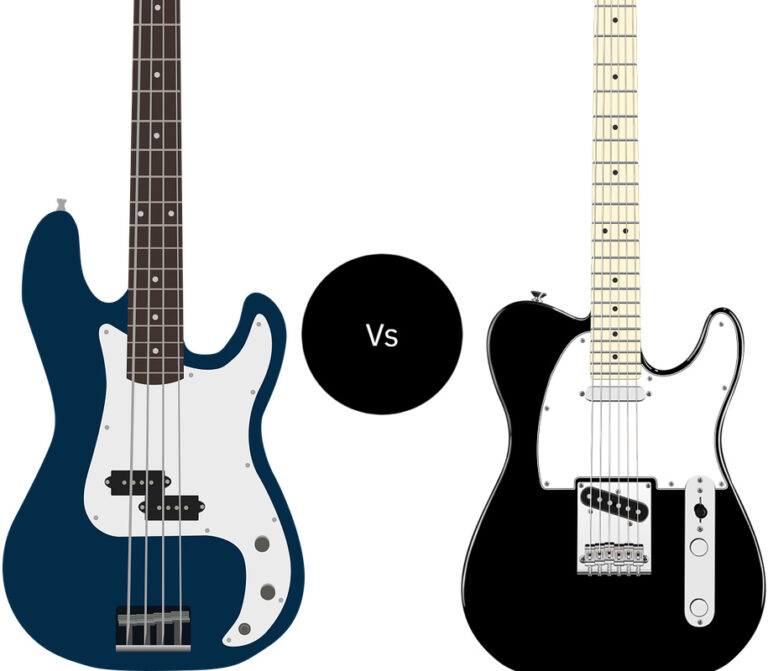Electric and bass guitars may look pretty much the same, especially to someone not much versed with guitars or musical instruments. Bass is also an “electric guitar” on a broad level, and as far as working, construction and appearances are concerned. However, both of these are very different instruments; and play distinct roles and serve different purposes.
In short:
The basic difference between electric and bass guitars is that bass guitars have larger necks and less number of strings — usually four. A larger neck makes the bass considerably bigger and heavier than electric guitars. The strings are also much thicker than electric guitars. There are more differences that we’ll discuss in this article.
Guitars attract attention, and guitarists in a band are usually the center of attention where all eyes are fixed. A lot of young teenagers get into music inspired by guitarists. This is, however, not to say guitarists are all-show and have no substance. Playing the guitar is an art, and only a handful of people are able to truly master it. But, there will always be some romanticism attached to playing the guitar.
On the other hand, basses take much of a back seat as far as showmanship is concerned. Basses go unnoticed most of the time though they contribute to the groove, which ironically makes people start moving their feet!
Differences Between Bass Guitars and Electric Guitars
General Appearance
Someone who plays the guitar will feel out of place when holding a bass for the first time. This is because bass guitars are typically much bigger and heavier than electric guitars. A standard bass guitar is around 10 inches longer than an electric guitar and usually weighs around a few pounds more.
A person with a keen eye would notice that another obvious difference between the two is the number of strings and tuners in the headstock.
Apart from this both the instruments looks very similar including the overall design, construction, pickups, and knobs.
Construction
Both electric and bass guitars are commonly made of solid wood, but bass guitars have a thicker body. Commonly used woods include alder, swamp ash, mahogany, maple, and pine.
Electric guitars also have hollow-body variants such as the semi-acoustic guitars. Hollow-body electric guitars are lighter in weight than both standard electric and bass guitars.
Bass guitars also need a stronger overall construction especially the neck and neck joint because of the thicker strings which are under much more tension.
Strings

One of the most noticeable and contrasting differences between a regular electric and bass is the number of strings and their thickness, which is evident even from afar. The most common basses have four thick strings compared to six thinner strings in electric guitars.
Though not common, bass guitars with five, six, or even more strings exist. Nevertheless, they are always thicker than the ones in electric guitars.
Another difference in strings between the two is that while electric guitars have three wound and three plain (or unwound) strings, all four of the strings in a bass guitar are wound.
String winding is a method of string construction that has two parts — a core and a winding wire. The winding wire is tightly wrapped around the core string. Wound strings are able to produce a lower pitch than plain strings at the same thickness which is why they are used for the low strings in guitars.
The strings in a bass guitar are under much more tension than in electric guitars. This is due to the heavier thickness and the increased scale length. Both these factors require that the strings be in comparatively more tension to be in their respective tuning.
Scale Length

Scale length is the vibrating length of the string and is the distance between the nut and the guitar’s bridge. Most basses have a scale length of around 34 or 35 inches compared to 25 inches for a regular electric guitar. Fender guitars usually have a scale length of 25.5 inches while Gibson’s are a bit shorter at 24.75 inches.
It is also one of the most characteristic differences between the two types of guitar and is pretty unmistakable even at a first glance.
Scale lengths also affect the guitar’s playability. A standard bass has 24 frets but because of the larger scale length, the frets are spaced further apart. This requires more finger dexterity to be able to quickly change notes.
Sound
The key difference between a bass and an electric guitar is the tone they produce. As soon as you play a few notes you hear the low end. The low-end pitches are great for the rhythmic section and contribute to the grooves.
While the sound of the bass guitar is often harder to discern in a song with many instruments if you removed the bassline the song would sound “empty”. A great bassline works to gel together the different parts of a band and provides a structure to the song by helping to combine the melody and beat together.
Guitars on the other hand provide harmony in a band along with the melody or part of the melody. Guitars have a much wider pitch range which makes them a perfect instrument for this.
You can see guitarists performing a solo (melody) but bass solos are not too common. Most bass solos are done usually with a different (higher pitch) tuning that includes a C-string (usually a 5-string bass).
Other Non-Apparent Differences
Tuning
The tuning of the strings in a bass guitar is E–A–D–G, the same as the lower four strings of a standard guitar but an octave lower. This gives basses the signature lower pitch.
In addition to standard 4-string bass guitars, a 6-string bass also exists and is used by some bassists. While the tuning in a standard 4-string bass is the same as the lower four strings of a guitar. It is different in 6-string basses which are tuned to B–E–A–D–G–C while a standard 6-string guitar is tuned to E–A–D–G–B–E.
Pitch Range
Pitch range is the measurement of the lowest and the highest pitch an instrument can produce. Bass guitars can go much low and have a smaller pitch range than guitars.
The pitch range of a standard 4-string bass having 24 frets is E1 to G4 or 41.20 Hz to 392.00 Hz. A 5-string bass having a B-string tuned to B0 can go further low to 30.868 Hz.
The pitch range of a standard guitar is E2 to E6 or 82.40 Hz to 1318.51 Hz.
Need for a Higher-Wattage Amp
Bass guitars to be at an audible level in an ensemble of different instruments need a much higher-rated amp. This is because lower frequencies need to push out more air to produce the bass thump. In a typical performance, a bass amp might be anywhere between 3 to 8 times more powerful than a guitar amp to be heard and felt in its intended manner.
Playing Style
Bass guitars are often used without effects and when used, the intensity and number of effects are generally kept to the minimum. While for guitars, distortion, reverb, etc., and other effects are almost the staple for genres like rock, blues, and metal.
Guitar players also typically use picks to strum the strings, while for bass, it is more common for guitarists to use their fingers. Also, bassists usually play notes rather than chords while guitarists play notes as well as chords but mostly chords.
Price
Bass guitars are often more expensive than electric guitars.
Purpose and Role
Bassists usually play notes, the progression of which forms the bassline. The notes in a bassline usually are mostly repetitive. Therefore, it is generally easier to get started with bass guitars.
Electric guitars are commonly part of the harmony and the melody and generally have complex chord changes and progressions. They also require more complex techniques to play certain styles.
Bass is more of a group instrument, you can’t just play the bass alone, for example by a campfire and sing. While the guitar is more versatile and can be played perfectly with or without a band.
Bass guitars play a significant part in a band where it’s the part of the rhythm section. The rhythm section is what provides the rhythm, harmony, and pulse in a song or performance. In a typical band, the rhythm section may consist of a drummer, a rhythm guitarist, a bass guitarist, and a synth bass.
Similarities Between Bass Guitar and Electric Guitar
Body
Both basses and electric guitars are commonly made of solid wood. Cheaper ones are usually made of pinewood, whereas you’ll find mahogany and swamp on higher-end guitars which are true hardwoods.
If you look closely you can see that electric guitars have knobs for volume and tone control on the body. You can also find similar knobs on basses.
Both the guitars also have similar electronic pickup systems to convert the sound of the strings’ vibration into electrical signals.
Tuning
Bass guitars in standard tuning have the same tuning as the four lower strings of a regular guitar — just an octave lower. Owing to this, the note produced at each fret is the same as that on a standard guitar. The pitch however is lower as all the strings are tuned an octave below.
External Accessories
Both basses and electric guitars rely on an electrical system that includes external devices like the amplifier to work and produce sound.
Related Questions
How Do I Identify a Bass Guitar?
Bass guitars have four thick strings compared to six thinner strings in an electric or acoustic guitar. If you look closely, all of the four strings in bass guitars are wound, whereas an electric guitar typically has three wound and three plain strings. The neck of a bass guitar is also much longer.
Can You Play an Electric Guitar as a Bass?
You cannot put bass guitar strings on an electric guitar because of the difference in scale length. However, you can use an effects pedal like an octave pedal to shift the pitch of your guitar one or more octaves down.
It wouldn’t sound the best, especially without a bass guitar amp but could be a fun experiment.
Are All Bass Guitars Electric?
No, acoustic bass guitars also exist. Though they are also almost always have a pickup and used with an amp. This is because an acoustic bass guitar is simply not much audible even in a small gig where all the other instruments are played acoustically.
Can You Play Bass if You Know Guitar?
If you know guitar it would certainly be easier for you to start playing bass. Though you wouldn’t instantly become a bassist, the techniques transfer well. Nobody can take away your finger dexterity, for instance, it will definitely help a lot.
But, you’ll have to be very open and not try too much of the guitar stuff on bass and learn it as a new instrument. See how it interacts with other parts of the band such as the drummer, for example. There’s much more to it, but it is beyond the scope of this article.
Conclusion
We hope this article answers your doubts on “bass guitars vs electric guitars”. Bass guitars can’t be thought of as a guitar with two fewer strings, they both are very different instruments and serve distinct roles. Nonetheless — they both are awesome instruments!
Many of the groovy songs that we have heard or love contain a bassline that incorporates a bass guitar. A lot of us cannot hear it unless we train our ears but once we do, it changes everything. It makes you appreciate bass guitars more unlike guitars which are in-your-face, and you just cannot ignore them! Not that there is anything wrong with it, though.
If you’re trying to choose one of the instruments to learn, I’d advise you to go to a music store and get a feel for both. You can also search YouTube to see people playing bass guitars and electric guitars in isolation (which means not in a band setting). This might inspire you and steer you towards the instrument you might love in the future!


